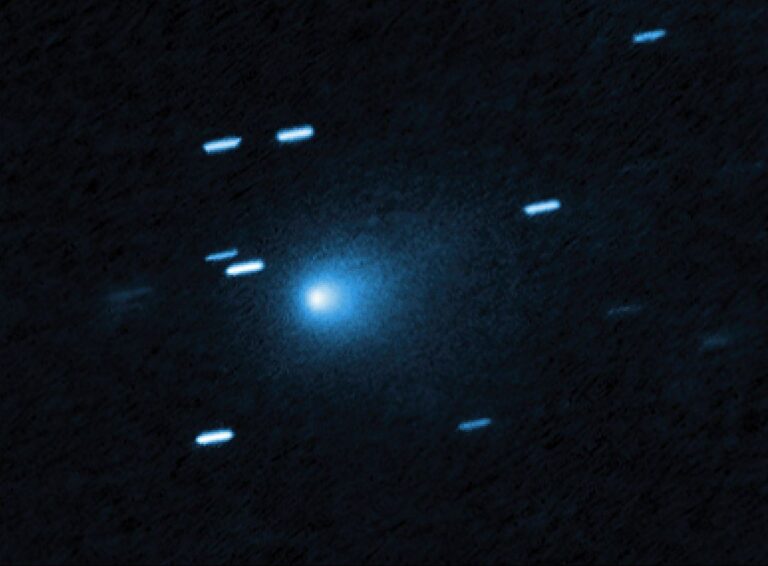Key Takeaways:
Quasars are the intensely luminous centers of distant galaxies that are powered by huge black holes. This new study has looked at one of these energetic objects — known as SDSS J1106+1939 — in great detail, using the X-shooter instrument on ESO’s VLT at the Paranal Observatory in Chile. Although black holes are noted for pulling material in, most quasars also accelerate some of the material around them and eject it at high speed.
“We have discovered the most energetic quasar outflow known to date,” said Nahum Arav from Virginia Tech in Blacksburg. “The rate that energy is carried away by this huge mass of material ejected at high speed from SDSS J1106+1939 is at least equivalent to 2 million million times the power output of the Sun. This is about 100 times higher than the total power output of the Milky Way Galaxy — it’s a real monster of an outflow. This is the first time that a quasar outflow has been measured to have the sort of very high energies that are predicted by theory.”
Many theoretical simulations suggest that the impact of these outflows on the galaxies around them may resolve several enigmas in modern cosmology, including how the mass of a galaxy is linked to its central black hole mass and why there are so few large galaxies in the universe. However, whether or not quasars were capable of producing outflows powerful enough to produce these phenomena has remained unclear until now.
The newly discovered outflow lies about a thousand light-years away from the supermassive black hole at the heart of quasar SDSS J1106+1939. This outflow is at least five times more powerful than the previous record holder. The team’s analysis shows that a mass of approximately 400 times that of the Sun is streaming away from this quasar per year, moving at a speed of 5,000 miles (8,000 kilometers) per second.
“We couldn’t have got the high-quality data to make this discovery without the VLT’s X-shooter spectrograph,” said Benoit Borguet from Virginia Tech. “We were able to explore the region around the quasar in great detail for the first time.”
As well as SDSS J1106+1939, the team also observed one other quasar and found that both of these objects have powerful outflows. As they are typical examples of a common, but previously little-studied type of quasars, these results should be widely applicable to luminous quasars across the universe. Borguet and colleagues are currently exploring a dozen more similar quasars to see if this is the case.
“I’ve been looking for something like this for a decade,” said Arav, “so it’s thrilling to finally find one of the monster outflows that have been predicted!”
Quasars are the intensely luminous centers of distant galaxies that are powered by huge black holes. This new study has looked at one of these energetic objects — known as SDSS J1106+1939 — in great detail, using the X-shooter instrument on ESO’s VLT at the Paranal Observatory in Chile. Although black holes are noted for pulling material in, most quasars also accelerate some of the material around them and eject it at high speed.
“We have discovered the most energetic quasar outflow known to date,” said Nahum Arav from Virginia Tech in Blacksburg. “The rate that energy is carried away by this huge mass of material ejected at high speed from SDSS J1106+1939 is at least equivalent to 2 million million times the power output of the Sun. This is about 100 times higher than the total power output of the Milky Way Galaxy — it’s a real monster of an outflow. This is the first time that a quasar outflow has been measured to have the sort of very high energies that are predicted by theory.”
Many theoretical simulations suggest that the impact of these outflows on the galaxies around them may resolve several enigmas in modern cosmology, including how the mass of a galaxy is linked to its central black hole mass and why there are so few large galaxies in the universe. However, whether or not quasars were capable of producing outflows powerful enough to produce these phenomena has remained unclear until now.
The newly discovered outflow lies about a thousand light-years away from the supermassive black hole at the heart of quasar SDSS J1106+1939. This outflow is at least five times more powerful than the previous record holder. The team’s analysis shows that a mass of approximately 400 times that of the Sun is streaming away from this quasar per year, moving at a speed of 5,000 miles (8,000 kilometers) per second.
“We couldn’t have got the high-quality data to make this discovery without the VLT’s X-shooter spectrograph,” said Benoit Borguet from Virginia Tech. “We were able to explore the region around the quasar in great detail for the first time.”
As well as SDSS J1106+1939, the team also observed one other quasar and found that both of these objects have powerful outflows. As they are typical examples of a common, but previously little-studied type of quasars, these results should be widely applicable to luminous quasars across the universe. Borguet and colleagues are currently exploring a dozen more similar quasars to see if this is the case.
“I’ve been looking for something like this for a decade,” said Arav, “so it’s thrilling to finally find one of the monster outflows that have been predicted!”










